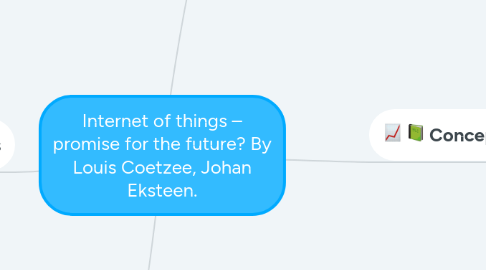
1. Application
1.1. Simplified manual proximity trigger
1.1.1. Things can communicate their identity when they are moved into the sensing space of a sensor. Once the identity is known and communicated, a specific action or transaction can be triggered.
1.2. Simple and direct user feedback
1.2.1. Things can incorporate simple mechanisms to provide feedback to a human present in the environment.
1.3. Automatic proximity trigger
1.3.1. An action is triggered automatically when the physical distance of two things drops below (or passes) a threshold.
1.4. Automatic sensor triggering
1.4.1. A smart (or cooperative) thing can collect data via any type of sensor including temperature, acceleration, orientation, vibration and humidity.
1.5. Automatic product security
1.5.1. A thing can provide derived security (information) based on the interaction between the thing and its cyberspace representation.
1.6. Extensive user feedback
1.6.1. Things can provide rich services to a human.
1.7. Mind changing feedback
1.7.1. The combination of real world and cyberspace might generate a new level of changing behaviours in people.
2. Challenges
2.1. Security and Privacy
2.1.1. With all of this IoT data being transmitted, the risk of losing privacy or being hacked increases.
2.2. Connectivity
2.2.1. Each thing is providing data. It may be challenging finding ways to reliably store and interpret the masses of data through scalable applications.
2.3. Complexity
2.3.1. The IoT is a diverse and complex network. Any failure or bugs in the software or hardware will have serious consequences.
3. Evolution of IoT
3.1. Internet of Computers
3.1.1. The Internet started as the “Internet of Computers”, a global network with services such as the World Wide Web built on top of the original platform.
3.2. Internet of People
3.2.1. It created concepts such as the Social Web, mobile Internet access and applications, where content is created and consumed by connected people (an estimated 1 billion people make up the Internet of People). This trend is also evidenced by the exponential growth of social networking services.
3.3. Internet of Things
3.3.1. Devices are increasingly fitted with sensors and actuators; the combination of the above creating an environment where devices are connected to the network, has the ability to sense, compute, act and thus intelligently become part of the Internet. In addition, physical objects are increasingly fitted with tags (e.g. radio-frequency identification or Quick Response codes (QR-codes) which could be sensed or scanned by devices. This combination links the physical world to cyberspace through the smart device.
3.3.1.1. 4 Dimensions of IoT
3.3.1.1.1. Item identification("Tagging things")
3.3.1.1.2. Sensors and wireless sensor networks
3.3.1.1.3. Embedded systems("Thinking things")
3.3.1.1.4. Nano-technology("Shrinking things")

